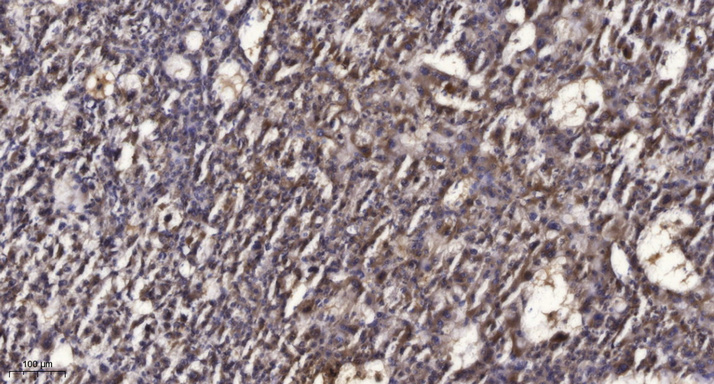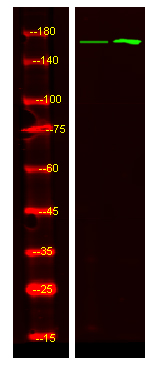产品名称
Rad50 (phospho-Ser635) Rabbit Polyclonal Antibody
别名
DNA repair protein RAD50 (hRAD50) (EC 3.6.-.-)
存储缓冲液
Liquid in PBS containing 50% glycerol, 0.5% BSA and 0.02% New type preservative N.
Human Gene Link
https://www.uniprot.org/uniprot/10111
Human Swissprot No.
Q92878
Human Swissprot Link
https://www.uniprot.org/uniprotkb/Q92878/entry
Mouse Swissprot No.
P70388
Mouse Swissprot Link
https://www.uniprot.org/uniprotkb/P70388
Rat Gene Link
https://www.uniprot.org/uniprot/64012
Rat Swissprot Link
https://www.uniprot.org/uniprotkb/Q9JIL8
免疫原
Synthesized phosho peptide around human Rad50 (Ser635)
特异性
This antibody detects endogenous levels of Human Rad50 (phospho-Ser635)
稀释度
WB 1:500-2000;IHC-p 1:50-300
宿主
Polyclonal, Rabbit,IgG
背景介绍
RAD50 double strand break repair protein(RAD50) Homo sapiens The protein encoded by this gene is highly similar to Saccharomyces cerevisiae Rad50, a protein involved in DNA double-strand break repair. This protein forms a complex with MRE11 and NBS1. The protein complex binds to DNA and displays numerous enzymatic activities that are required for nonhomologous joining of DNA ends. This protein, cooperating with its partners, is important for DNA double-strand break repair, cell cycle checkpoint activation, telomere maintenance, and meiotic recombination. Knockout studies of the mouse homolog suggest this gene is essential for cell growth and viability. Mutations in this gene are the cause of Nijmegen breakage syndrome-like disorder.[provided by RefSeq, Apr 2010],
组织表达
Expressed at very low level in most tissues, except in testis where it is expressed at higher level. Expressed in fibroblasts.
细胞定位
Nucleus . Chromosome, telomere . Chromosome . Localizes to discrete nuclear foci after treatment with genotoxic agents. .
信号通路
Homologous recombination;Non-homologous end-joining;
功能
cofactor:Binds 1 zinc ion per homodimer.,domain:The zinc-hook, which separates the large intramolecular coiled coil regions, contains 2 Cys residues that coordinate one molecule of zinc with the help of the 2 Cys residues of the zinc-hook of another RAD50 molecule, thereby forming a V-shaped homodimer. The two heads of the homodimer, which constitute the ATP-binding domain, interact with the MRE11A homodimer.,function:Component of the MRN complex, which plays a central role in double-strand break (DSB) repair, DNA recombination, maintenance of telomere integrity and meiosis. The complex possesses single-strand endonuclease activity and double-strand-specific 3'-5' exonuclease activity, which are provided by MRE11A. RAD50 may be required to bind DNA ends and hold them in close proximity. This could facilitate searches for short or long regions of sequence homology in the recombining DNA templates, and may also stimulate the activity of DNA ligases and/or restrict the nuclease activity of MRE11A to prevent nucleolytic degradation past a given point. The complex may also be required for DNA damage signaling via activation of the ATM kinase. In telomeres the MRN complex may modulate t-loop formation.,miscellaneous:In case of infection by adenovirus E4, the MRN complex is inactivated and degraded by viral oncoproteins, thereby preventing concatenation of viral genomes in infected cells.,PTM:Phosphorylated upon DNA damage, probably by ATM or ATR.,sequence caution:Contaminating sequence. Potential poly-A sequence.,similarity:Belongs to the SMC family. RAD50 subfamily.,similarity:Contains 1 zinc-hook domain.,subcellular location:Localizes to discrete nuclear foci after treatment with genotoxic agents.,subunit:Component of the MRN complex composed of two heterodimers RAD50/MRE11A associated with a single NBN. Component of the BASC complex, at least composed of BRCA1, MSH2, MSH6, MLH1, ATM, BLM, RAD50, MRE11A and NBN. Found in a complex with TERF2. Interacts with RINT1. Interacts with BRCA1 via its N-terminal domain. Interacts with DCLRE1C/Artemis.,tissue specificity:Expressed at very low level in most tissues, except in testis where it is expressed at higher level. Expressed in fibroblasts.,
纯化
The antibody was affinity-purified from rabbit serum by affinity-chromatography using specific immunogen.


